Estate Jewelry: Sapphires, Marble Apples, and Two Fish With Crackers
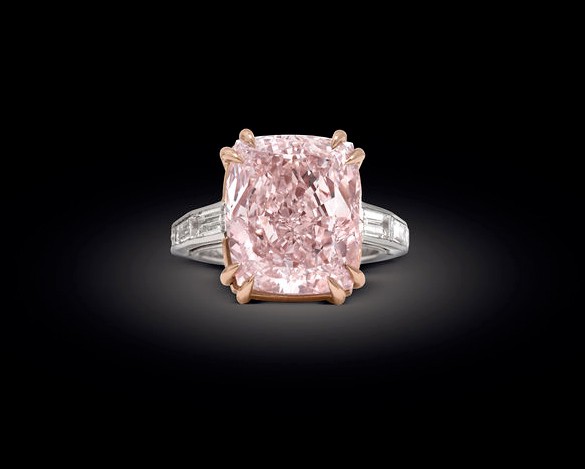
Oh, no biggie, this is just a 12.27-ct natural fancy pink diamond, certified Type IIa, nearly internally flawless and set in an antique Cartier platinum and 18k rose gold mount with baguette-cut white diamonds. Pssssh; whatever.
It’s called the “Majestic Pink,” and while the dealer, M.S. Rau, doesn’t disclose the price of the ring on their website, JCK has it down as $7.85 million. The ring will go on sale on August 8 via a partnership the luxury website 1stdibs.com.
This diamond is definitely something special. You guys know by now that a certification of Type IIa means the stone contains no nitrogen, making it super transparent and placing it in the company of diamonds from India’s famous Golconda mine. Type IIa is a rare classification to begin with, but even rarer to find in pink diamonds. There are only a few pink IIas in existence, two of which are part of the Iranian crown jewels. (And do you remember the Clark Pink, the 9-ct fancy purplish-pink diamond ring that was auctioned at Christie’s back in April? That baby ultimately went for $15.7 million.) The Majestic Pink is also nearly flawless — another rarity, as pink diamonds typically have more inclusions (or flaws) than other diamonds.
M.S. Rau sent me a very pretty flyer on this piece, and I’ve hung it up, as it’s the closest I’m ever going to get to owning something “majestic.” If you’re a glutton for punishment, go see the ringin person at the Baltimore Summer Antiques Show from August 23 to 26.
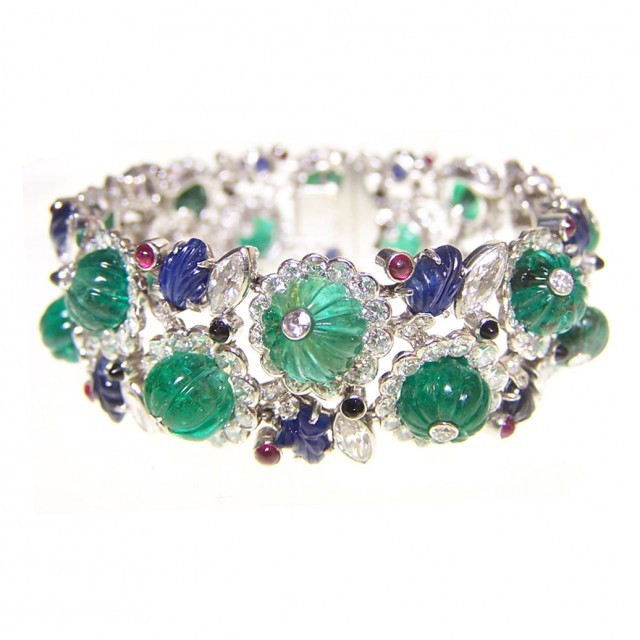
“Tutti Frutti,” one of Cartier’s most famous jewelry styles, debuted in the 1920s. Using Indian gemstones and mimicking traditional Indian jewelry style, Cartier designers grouped elaborately carved and cabochon stones into fantastic patterns that are a joyful riot of color.
Parisian jeweler Henri Picq did a lot of work for Cartier, and he was renowned both for his platinum jewelry as well as his Tutti Frutti pieces. He created this bracelet, which scatters large carved emeralds and sapphires among diamonds and tiny cabochon rubies and onyx. Circa 1925.
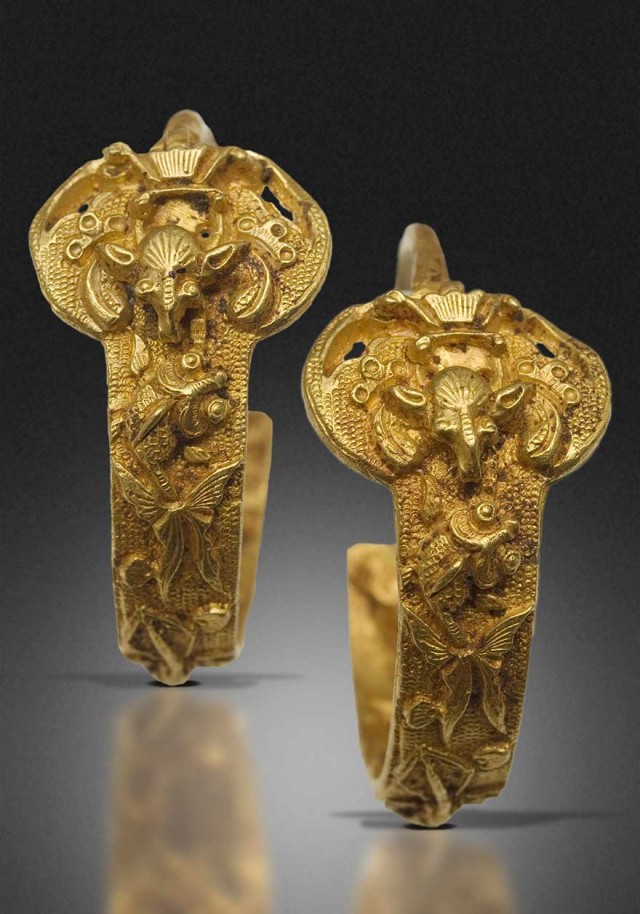
Circa the 17th century, these Chinese Ming Dynasty gold hoop earrings feature a rebus — i.e., they use images to represent words or meanings. The dealer lists the images and their interpretations:
Lotus and Fish: May you have a abundance of wealth and honour;
Gold Fish: May you have an excess of gold;
Shrimp: You have the ability to change your fate;
Fish: Contentment;
Cat Fish: May your wishes come true year after year and may every year be auspicious;
Two Fish with Crackers: May you have plenty year after year;
Dragonfly: May the river stay clear and the sea calm;
Butterfly: A joyful encounter.
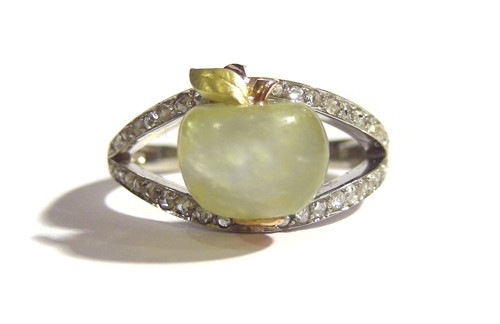
This ridiculously cute “Apple of my Eye” ring features a Connemara marble apple (with colored gold stem and leaf) set within a platinum and rose diamond eye-shaped setting. Look at it from the side!
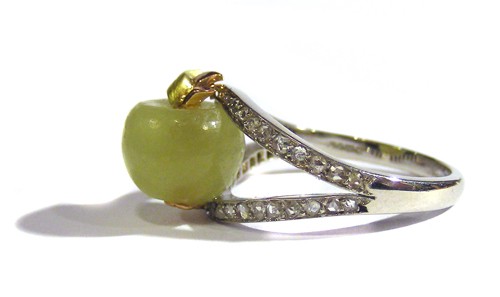
Note: Connemara is an area in western Ireland, and the marble found there dates back to prehistoric times. It’s still quarried today and is used both in jewelry and as a building material. This area also produced Peter O’Toole (he has birth certificates for both Connemara and Leeds, England), so … I owe you one, Connemara.
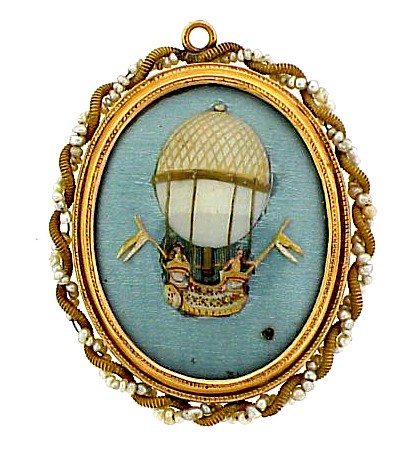
In 1783, brothers Joseph-Michel and Jacques-Étienne Montgolfier launched the first manned hot-air balloon. Originally from Annonay, France, the brothers had, for years, been captivated by the possibilities of balloon-borne flight, and their experiments eventually captured the interest of King Louis XVI and Marie Antoinette. One of their first demonstrations was performed at Versailles, in front of the royal pair and an accompanying crowd, with a balloon that was “manned” by a duck, a rooster, and a sheep. The flight lasted around eight minutes and reached 1,500 feet before landing safely.
The brothers later held manned and tethered test flights (Étienne himself went up in one), but the official first untethered launch carrying two men took place on November 21, 1783. Due to the danger involved, King Louis had proposed sending criminals up in the balloon, but Jean François Pilâtre de Rozier, a chemistry and physics teacher, volunteered to go up instead. He was joined by the Marquis d’Arlandes, an army officer. A first-hand report in the December 1783 issue of The Gentleman’s Magazine states that, after a delay due to repairs: “The machine was then seen to rise in quite a majestic manner, and when it reached the elevation of about 250 feet, the intrepid travellers, shaking their hats, saluted the spectators.” The flight lasted 25 minutes and crossed above Paris at a distance of 3,000 feet, and they eventually landed safely outside the city. Ten days later, two other French inventors, Jacques Charles and Nicolas-Louis Robert, successfully flew the first hydrogen gas balloon from Paris. If you’re interested, there’s a video here that covers the competition between the inventors, as well as the differences in hot air and hydrogen balloon technologies.
The successful launches resulted in huge public excitement about ballooning, and balloon designs began to appear in furniture, clothing, jewelry, and decorative items. Beautiful depictions of balloon launches can be seen here and here, while this article delves deeper into the “balloon mania” of the time, and also features some fantastic 18th-century caricatures of balloon-inspired fashion. (And they’re totally Kate Beaton territory, btw.)
ANYWAY, yes, sorry, this column is about jewelry, I know. Here’s a great, rare example of balloon-related jewelry of the time. It’s an 18k yellow gold pendant/locket that dates to around 1785, and is probably French (it’s not hallmarked, and was probably custom-made). The balloon is carved from mother of pearl with both gilded and painted details, while the background is blue silk. The piece is protected by convex glass set in a beautiful 18k yellow gold frame with seed pearls. The back of the locket, also with glass and silk, features a mother of pearl plaque painted with the initials “F.H.”
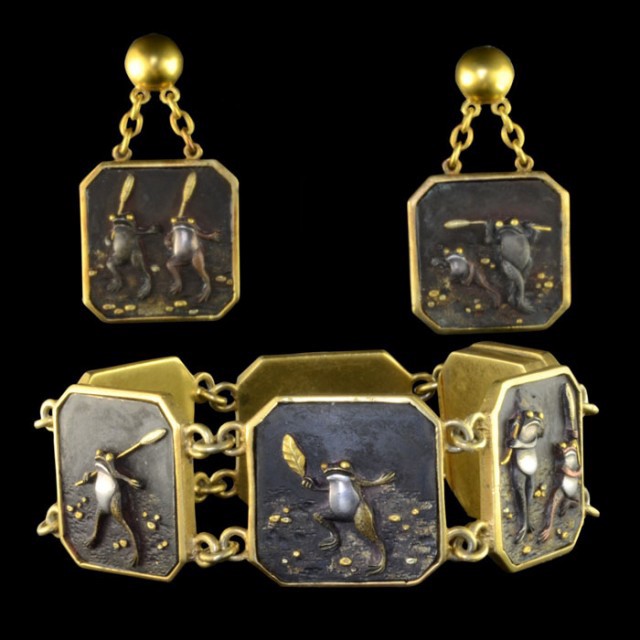
This European set of bracelet and earrings (c.1875) features Japanese shakudō panels mounted in yellow gold. Shakudō, a traditional Japanese material, is an alloy of gold and copper; the dark bluish-black patina is achieved by applying a compound called rokushō to the piece and then heating it. Shakudō was introduced to the West in the mid-19th century, and it soon became popular to use little panels such as these in contemporary jewelry. This set, which features sweet little scenes of frogs, includes one panel signed in Japanese.
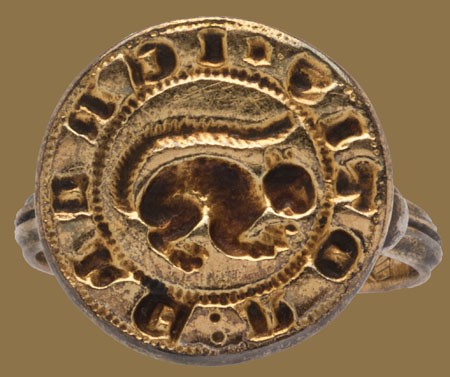
The bezel of this gold ring is a Gothic seal (or signet) that dates to the 13th or 14th century, while the band was added later. Medieval seals often used symbolic animal motifs, and this one features a little squirrel holding a nut. Around the edge of the seal, Lombardic letters read “JOANNE NOTIS,” or “Using the seal of Joanna.”
So, it’s interesting that this seal may have originally belonged to a woman, but it’s even more interesting that the motif was a squirrel. Squirrels were common symbols for medieval seals — they could represent diligence or industriousness, or even secrecy (as squirrels keep hidden stores of food). However, they could also jokingly refer to women and sexuality. Take a look at this one, which actually says “I crack nuts.” Yep.
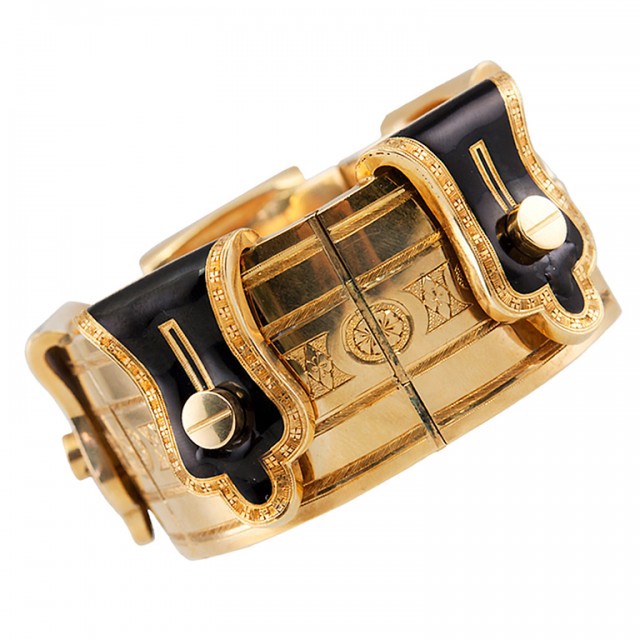
You guys are well aware by now that I adore 19th-century cuff bracelets for their gorgeous enameling and clever designs. Here’s another lovely Late Victorian example: from France, circa 1900, the cuff pairs engraved 18k gold with black enamel, in a design that mimics overlapping swatches of material fastened down by buttons. Fantastic.
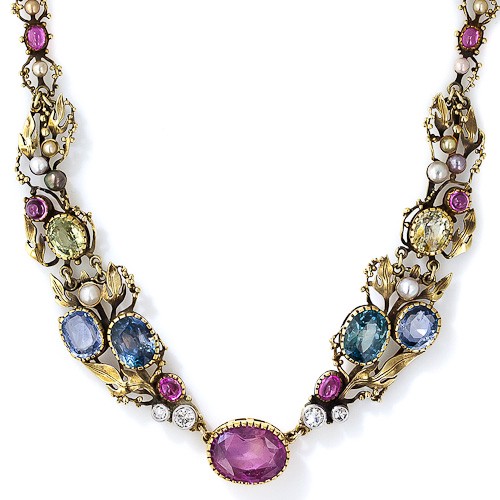
This Arts & Crafts necklace (circa 1900) features 25 carats of multi-colored sapphires in shades of blue, pink, teal, and yellow. The sapphires are set within a frame of flowing 14 and 18k gold leaves, which branch upward from a central 8.5-carat raspberry-pink sapphire. Also interspersed throughout the leaves are diamonds and pearls. This is a super-pretty piece, with an overall shape that I think would be really flattering on.
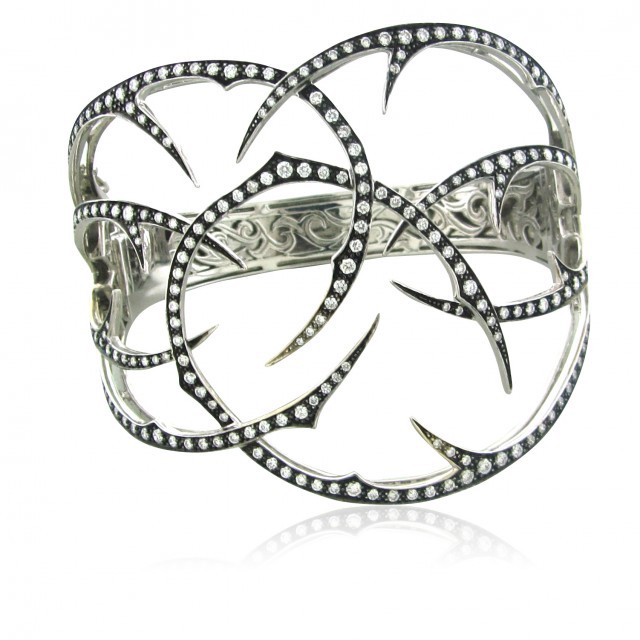
Here’s another contemporary designer whose work is reaching the secondary market. Award-winning English designer Stephen Webster is a rock star of the jewelry industry, with a huge celebrity following, but his creations are worthy of the accolades. He’s also been creative director of Garrard’s, the crown jewelers, since 2008. He’s renowned for unusual yet high-quality jewelry, and I actually interviewed him a while back in relation to a collaboration he had with Wedgwood — yes, the pottery/china company — which resulted in a whimsical and uniquely English collection that teamed jasperware with sterling silver, and featured motifs that included British bulldogs and roses.
Thorns are a common subject in Webster’s jewelry, and this piece features diamonds set into a delicate 18k white gold thorn cuff, with an intricately worked interior. Gorgeous!
Previously: Bird Heads, Bridal Crowns, and an Eyeball.
Related: A Hairpin editor talks about her Monica McLaughlin-inspired obsession with estate jewelry.
Monica McLaughlin is reachable at [email protected], should anyone wish to hire her services in exchange for money or 12-carat pink diamonds.